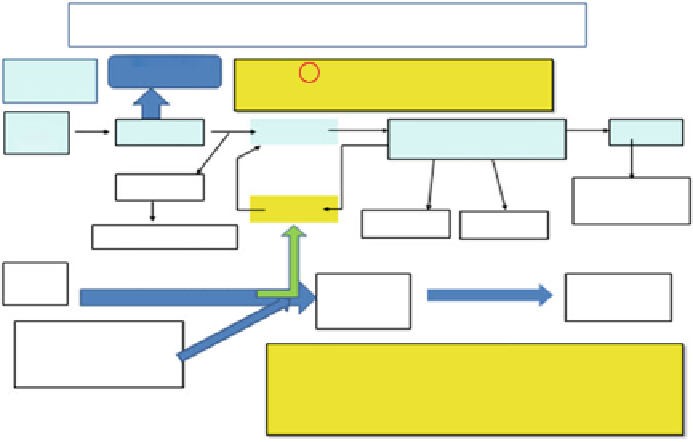Environmental Engineering Reference
In-Depth Information
Strategic new Si technology
-Two approaches to innovative Si technology
Metallurgical
Purification
Siemens
Process
1
More than Siemens
CVD Yield: 25
→ > 80 %
Cz of Fz
C
SiO
2
{Rock}
[ SiHCl
3
]
SEG(poly)-Si
(Purity > 10 N)
MG-Si
SC-Si
CVD
Purity 98%
SiH
4
Slice
Cast
+ Slice
H
2
Shot
sc-Si
solar cell
[
SiCI
4
]
Plasma CVD
Ingot
Ribbon
Thin film solar cell
CL
2
Purification
(B, P < 1 ppm)
SiO2
(sand)
+
Up-grade
SOG-Si
Purified
power
Direct reduction
Carbon
or
Activated hydrogen
Beyond Siemens
Powder purification in advance
Drastic energy saving by skipping CVD (costdown)
Product only for PV
2
Fig. 9
Strategic new Si technology including two innovative approaches
precipitate SiO
2
. This process could not be
applied to desert sand directly due to low solubil-
ity of the sand which is composed primarily of
crystalline silica. We found that this problem
could be solved by applying the ball milling to
the sand which had been gravimetrically sepa-
rated and rinsed with HCl in advance. Thus, we
could merge the purifi cation process of desert
sand with that of amorphous silica as shown in
Fig.
11
. ICP-OES analysis verifi ed sub-ppm lev-
els of boron (B) and phosphorus (P) impurities in
the silica purifi ed from Sahara sand at Hassi
Messaoud location in Algeria. Metallic impuri-
ties are known to be segregated effectively by the
unidirectional solidifi cation process.
than 12 % was achieved (NEDO
1987
). It must
be noted that this effi ciency is higher than the
effi ciencies of conventional thin-fi lm solar cells.
Hence, we can get Si solar cells with reasonably
high effi ciency and durability once we have
SOG-Si. By omitting the energy-consuming
CVD process (~100 kWh/kg-Si) in the conven-
tional Siemens process (Figs.
9
and
10
), drastic
energy saving and production cost reduction
should be achieved.
6
Conclusions
and Recommendations
The importance of access to clean energy cannot
be overstated. Research, development and dem-
onstration (RD and D) are the foundation for
progress and change towards sustainable energy
systems throughout the world to protect the
global life-supporting systems and reduce the
risk of geopolitical confl icts over fossil fuel
resources which are quickly depleting materials.
We need more electricity from RE and more
investment and initiative to make solar energy
cost-effective and competitive. There are good
examples of business initiatives to enhance
5.3
Direct Reduction of Purifi ed
Silica to Silicon
In the 1980s, NEDO-supported Nippon sheet
glass/JFE Co. joint project, which reported that
purifi ed silica reduction with carbon powder in
an arc furnace using graphite shafts to feed pel-
leted SiO
2
and C to give 6 nine grade SOG-Si.
This Si was used to fabricate polycrystalline Si
solar cells. Energy conversion effi ciencies higher



Search WWH ::

Custom Search